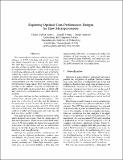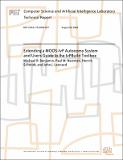Browsing Computer Science and Artificial Intelligence Lab (CSAIL) by Title
Now showing items 1187-1206 of 3804
-
Exploring Object Perception with Random Image Structure Evolution
(2001-03-01)We have developed a technique called RISE (Random Image Structure Evolution), by which one may systematically sample continuous paths in a high-dimensional image space. A basic RISE sequence depicts the evolution of an ... -
Exploring Optimal Cost-Performance Designs for RAW processors
(1998-06)The semiconductor industry roadmap projects that advances in VLSI technology will permit more than one billion transistors on a chip by the year 2010. The MIT Raw microprocessor is a proposed architecture that strives to ... -
Exploring Vision-Based Interfaces: How to Use Your Head in Dual Pointing Tasks
(2002-01-01)The utility of vision-based face tracking for dual pointing tasks is evaluated. We first describe a 3-D face tracking technique based on real-time parametric motion-stereo, which is non-invasive, robust, and self-initialized. ... -
Expressing Mathematical Subroutines Constructively
(1987-11-01)The typical subroutines that compute $\\sin(x)$ and $\\exp(x)$ bear little resemblance to our mathematical knowledge of these functions: they are composed of concrete arithmetic expressions that include many mysterious ... -
Extended Gaussian Images
(1983-07-01)This is a primer on extended Gaussian Images. Extended Gaussian Images are useful for representing the shapes of surfaces. They can be computed easily from: 1. Needle maps obtained using photometric stereo, or 2. Depth ... -
Extending 2-D Smoothed Local Symmetries to 3-D
(MIT Artificial Intelligence Laboratory, 1985-11)3-D Smoothed Local Symmetries (3-D SLS's) are presented as a representation for three-dimensional shapes. 3-D SLS's make explicit the perceptually salient features of 3-D objects and are especially suited to representing ... -
Extending a MOOS-IvP Autonomy System and Users Guide to the IvPBuild Toolbox
(2009-08-20)This document describes how to extend the suite of MOOS applications and IvP Helm behaviors distributed with the MOOS-IvP software bundle from www.moos-ivp.org. It covers (a) a straw-man repository with a place-holder MOOS ... -
Extending a Powerful Idea
(1980-07-01)Mathematics is much more than the manipulation of numbers. At its best, it involves simple, clear examples of thought so apt to the world we live in that those examples provide guidance for our thinking about problems ... -
Extending Binary Byzantine Agreement to Multivalued Byzantine Agreement
(1984-04)A binary Byzantine agreement algorithm can be extended to produce a multivalued Byzantine agreement algorithm. The resulting multivalued algorithm is cheaper than previously published algorithms when the cost of transmitting ... -
Extending Guzman's SEE Program
(1970-07-01)Adolfo Guzman's SEE program groups the regions of a two-dimensional scene into bodies, using, using local evidence in the scene to link regions together. This paper discusses an extended version of the SEE procedure that ... -
Extensions of a Theory of Networks for Approximation and Learning: Dimensionality Reduction and Clustering
(1990-04-01)The theory developed in Poggio and Girosi (1989) shows the equivalence between regularization and a class of three-layer networks that we call regularization networks or Hyper Basis Functions. These networks are also ... -
Extensions of a Theory of Networks for Approximation and Learning: Outliers and Negative Examples
(1990-07-01)Learning an input-output mapping from a set of examples can be regarded as synthesizing an approximation of a multi-dimensional function. From this point of view, this form of learning is closely related to regularization ... -
Extra-Retinal Signals Influence Induced Motion: A New Kinetic Illusion
(1980-05-01)When a moving dot, which is tracked by the eyes and enclosed in a moving framework, suddenly stops while the enclosing framework continues its motion, the dot is seen to describe a curved path. This illusion can be ... -
Extracting all the Randomness from a Weakly Random Source
(1998-08)In this paper, we give two explicit constructions of extractors, both of which work for a source of any min-entropy on strings of length n. The first extracts any constant fraction of the min-entropy using O(log^2 n) ... -
Extracting and Representing Qualitative Behaviors of Complex Systems in Phase Spaces
(1991-03-01)We develop a qualitative method for understanding and representing phase space structures of complex systems and demonstrate the method with a program, MAPS --- Modeler and Analyzer for Phase Spaces, using deep domain ... -
Extracting Qualitative Dynamics from Numerical Experiments
(1987-03-01)The Phase Space is a powerful tool for representing and reasoning about the qualitative behavior of nonlinear dynamical systems. Significant physical phenomena of the dynamical system---periodicity, recurrence, stability ... -
Extracting Salient Curves from Images: An Analysis of the Saliency Network
(1995-08-01)The Saliency Network proposed by Shashua and Ullman is a well-known approach to the problem of extracting salient curves from images while performing gap completion. This paper analyzes the Saliency Network. The ... -
Extracting topographic features from elevation data using contour lines
(MIT Artificial Intelligence Laboratory, 1977-05)This paper describes a method for finding such topographical features as ridges and valleys in a given terrain. Contour lines are used to obtain the desired result. -
An Extremum Principle for Shape from Contour
(1983-06-01)An extremum principle is developed that determines three-dimensional surface orientation from a two-dimensional contour. The principle maximizes the ratio of the area to the square of the perimeter, a measure of the ...



















